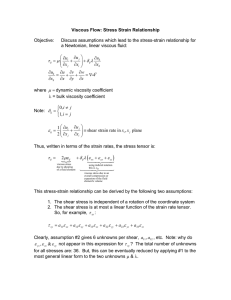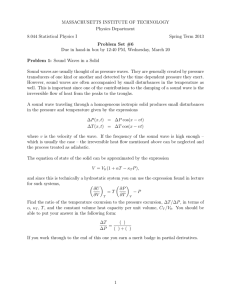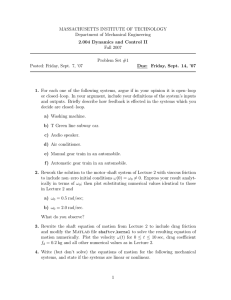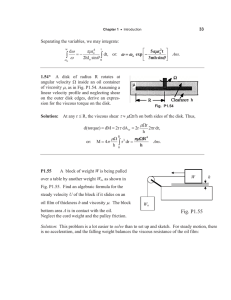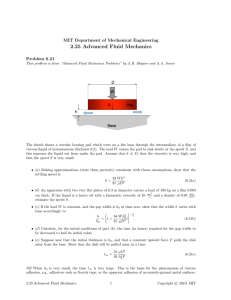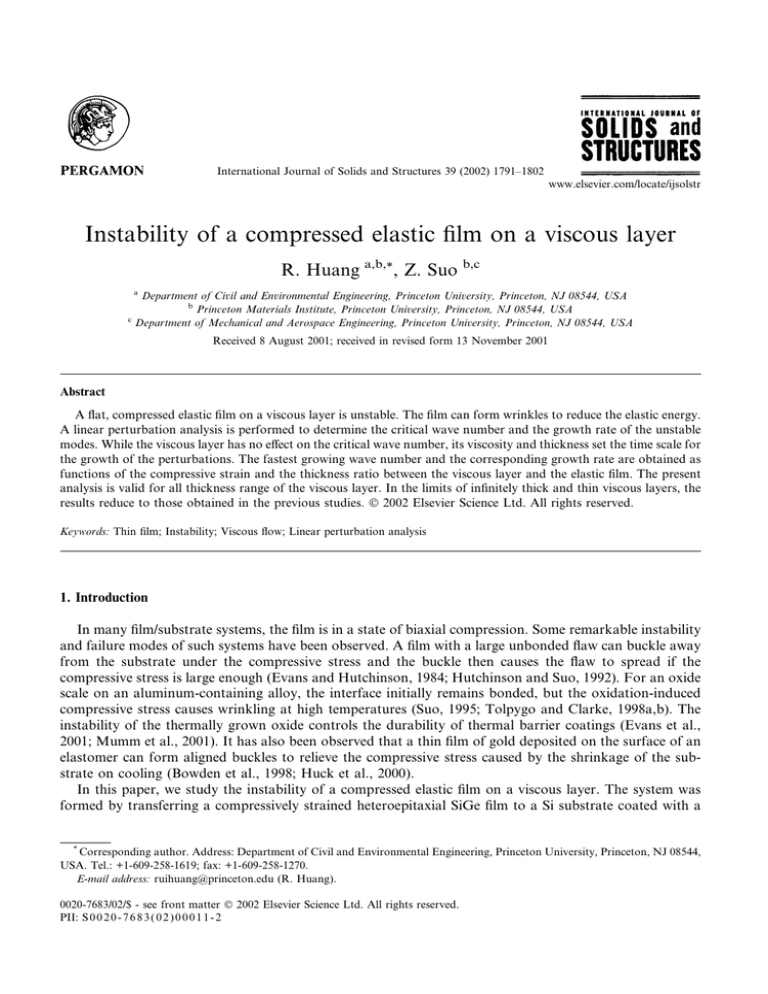
International Journal of Solids and Structures 39 (2002) 1791–1802
www.elsevier.com/locate/ijsolstr
Instability of a compressed elastic film on a viscous layer
R. Huang a,b,*, Z. Suo b,c
a
c
Department of Civil and Environmental Engineering, Princeton University, Princeton, NJ 08544, USA
b
Princeton Materials Institute, Princeton University, Princeton, NJ 08544, USA
Department of Mechanical and Aerospace Engineering, Princeton University, Princeton, NJ 08544, USA
Received 8 August 2001; received in revised form 13 November 2001
Abstract
A flat, compressed elastic film on a viscous layer is unstable. The film can form wrinkles to reduce the elastic energy.
A linear perturbation analysis is performed to determine the critical wave number and the growth rate of the unstable
modes. While the viscous layer has no effect on the critical wave number, its viscosity and thickness set the time scale for
the growth of the perturbations. The fastest growing wave number and the corresponding growth rate are obtained as
functions of the compressive strain and the thickness ratio between the viscous layer and the elastic film. The present
analysis is valid for all thickness range of the viscous layer. In the limits of infinitely thick and thin viscous layers, the
results reduce to those obtained in the previous studies. Ó 2002 Elsevier Science Ltd. All rights reserved.
Keywords: Thin film; Instability; Viscous flow; Linear perturbation analysis
1. Introduction
In many film/substrate systems, the film is in a state of biaxial compression. Some remarkable instability
and failure modes of such systems have been observed. A film with a large unbonded flaw can buckle away
from the substrate under the compressive stress and the buckle then causes the flaw to spread if the
compressive stress is large enough (Evans and Hutchinson, 1984; Hutchinson and Suo, 1992). For an oxide
scale on an aluminum-containing alloy, the interface initially remains bonded, but the oxidation-induced
compressive stress causes wrinkling at high temperatures (Suo, 1995; Tolpygo and Clarke, 1998a,b). The
instability of the thermally grown oxide controls the durability of thermal barrier coatings (Evans et al.,
2001; Mumm et al., 2001). It has also been observed that a thin film of gold deposited on the surface of an
elastomer can form aligned buckles to relieve the compressive stress caused by the shrinkage of the substrate on cooling (Bowden et al., 1998; Huck et al., 2000).
In this paper, we study the instability of a compressed elastic film on a viscous layer. The system was
formed by transferring a compressively strained heteroepitaxial SiGe film to a Si substrate coated with a
*
Corresponding author. Address: Department of Civil and Environmental Engineering, Princeton University, Princeton, NJ 08544,
USA. Tel.: +1-609-258-1619; fax: +1-609-258-1270.
E-mail address: ruihuang@princeton.edu (R. Huang).
0020-7683/02/$ - see front matter Ó 2002 Elsevier Science Ltd. All rights reserved.
PII: S 0 0 2 0 - 7 6 8 3 ( 0 2 ) 0 0 0 1 1 - 2
1792
R. Huang, Z. Suo / International Journal of Solids and Structures 39 (2002) 1791–1802
Fig. 1. A wrinkled elastic film on a viscous layer.
layer of glass (Hobart et al., 2000; Yin et al., 2001). Upon annealing above the glass transition temperature,
the glass flows like a viscous liquid and the SiGe film forms wrinkles, as shown in Fig. 1. The instability was
previously studied by Sridhar et al. (2001), in which the shear traction along the interface was assumed to be
zero and the displacement parallel to the interface was ignored. In this paper, we show that such simplifications are incorrect when the thickness of the viscous layer is small. Recently, we studied the wrinkling
process of this system by using the lubrication theory for the viscous flow and the non-linear plate theory
for the elastic film (Huang and Suo, 2002). The lubrication theory enabled us to do simulations beyond the
linear stability analysis. However, the assumption made in the lubrication theory requires that the thickness
of the viscous layer be small compared to the wavelength, and thus the analysis is not valid when the
thickness of the viscous layer is large. This paper presents a more rigorous analysis in that it is valid for all
thickness range of the viscous layer. In the limits of infinitely thick and thin viscous layers, the results from
the present analysis reduce to those from the previous studies.
The plan of this paper is as follows. In Section 2, we first consider the linear perturbations of the viscous
flow and the elastic deformation separately, and then couple them to study the stability of the perturbations. In Section 3, we discuss the results and compare with the previous studies. Section 4 gives the
concluding remarks.
2. Formulation and solution
As shown in Fig. 1, we consider an elastic film on a viscous layer, which in turn lies on a rigid substrate.
The viscous flow and the elastic deformation are coupled through the interface, where the displacements
and the tractions are assumed to be continuous.
2.1. Flow in a viscous layer
The flow is assumed to be slow such that the inertia can be neglected. The equation of motion reduces to
the equilibrium equation, i.e.,
rij;j ¼ 0;
ð1Þ
where rij is the stress tensor. The material of the layer is assumed to be linear viscous. Thus the stress
components relate to the velocities by
rij ¼ gðvi;j þ vj;i Þ pdij ;
ð2Þ
where g is the viscosity, vi is the velocity, and p is the pressure. The viscous layer is also assumed to be
incompressible, so that
vi;i ¼ 0;
ð3Þ
R. Huang, Z. Suo / International Journal of Solids and Structures 39 (2002) 1791–1802
1793
and
p ¼ 13rii :
ð4Þ
Under the above assumptions, the flow is referred to as the ‘‘Stokes flow’’ or the ‘‘creeping flow’’.
A trivial solution to Eqs. (1)–(4) corresponds to an infinite viscous layer on a rigid substrate with
constant thickness and free top surface. Now consider a perturbation along the surface to the trivial solution. Since the viscous layer is isotropic in the plane of its surface, the wave vector of the perturbation in
any direction is equivalent. We choose the direction to coincide with the x-direction of the coordinate, as
shown in Fig. 1. Consequently, the perturbed viscous layer is in a state of plane strain deformation in the
x–z plane, i.e., vx ¼ vx ðx; z; tÞ, vz ¼ vz ðx; z; tÞ, and vy ¼ 0. Because the surface of the viscous layer is infinite,
the perturbed field has the translational symmetry along the surface such that the location of the origin of
the x-coordinate is arbitrary. To simplify writing, we choose the origin such that the tractions at the surface
take the form:
rzz ðz ¼ H Þ ¼ q0 ðtÞ sinðkxÞ;
ð5Þ
rzx ðz ¼ H Þ ¼ s0 ðtÞ cosðkxÞ;
ð6Þ
where H is the thickness of the viscous layer, k is the wave number of the perturbation, q0 ðtÞ and s0 ðtÞ are
the time-dependent amplitudes of the surface tractions. The velocities at the bottom of the viscous layer are
set to be zero. Under these boundary conditions, a set of exact solutions to Eqs. (1)–(4) is obtained in
Appendix A. Of relevance to the present study are the velocities at the top surface, taking the form:
vz ðz ¼ H Þ ¼ vz ðtÞ sinðkxÞ;
ð7Þ
vx ðz ¼ H Þ ¼ vx ðtÞ cosðkxÞ:
ð8Þ
The amplitudes of velocities, vz ðtÞ and vx ðtÞ, are linearly related to the amplitudes of the surface tractions.
Dimensional considerations dictate that
vz ðtÞ ¼
1
ðc q0 ðtÞ þ c12 s0 ðtÞÞ;
2gk 11
ð9Þ
vx ðtÞ ¼
1
ðc q0 ðtÞ þ c22 s0 ðtÞÞ;
2gk 21
ð10Þ
where the dimensionless coefficients are (see Appendix A for details)
c11 ¼
1 sinhð2kH Þ 2kH
;
2 ðkH Þ2 þ cosh2 ðkH Þ
ð11Þ
c22 ¼
1 sinhð2kH Þ þ 2kH
;
2 ðkH Þ2 þ cosh2 ðkH Þ
ð12Þ
c12 ¼ c21 ¼
ðkH Þ2
2
ðkH Þ þ cosh2 ðkH Þ
:
ð13Þ
We can compare the present solution with three previous studies. In Sridhar et al. (2001), the shear
traction at the surface (s0 ) was assumed to be zero and the shear velocity at the surface (vx ) was ignored.
However, from the above exact solution, both the shear traction and the shear velocity are not zero, and
even when the amplitude of shear traction s0 is zero the shear velocity amplitude vx is not zero due to the
non-uniform normal traction (Eq. 10). When the thickness of the viscous layer is large compared to the
1794
R. Huang, Z. Suo / International Journal of Solids and Structures 39 (2002) 1791–1802
wavelength (kH 1), we have c21 c11 and thus vx vz if s0 ¼ 0. In the limit of an infinitely thick viscous
layer (kH ! 1), c21 ! 0 and vx ! 0 if s0 ¼ 0. Therefore, the analysis in Sridhar et al. (2001) is approximately correct for a thick viscous layer and approaches to the exact solution as the thickness approaches
infinity.
Recently we derived a set of equations that relate the velocities at the surface of a viscous layer to the
pressure and the shear tractions at the surface by using the lubrication theory (Huang and Suo, 2002). The
lubrication theory assumes that the thickness of the viscous layer is small compared to the characteristic
lengths in the lateral directions, i.e., kH 1. Here we show that the above exact solution reduces to the solution from the lubrication theory in the limit of a thin viscous layer. Retaining only the leading order of kH
3
2
in Eqs. (11)–(13), we have c11 ¼ ð2=3ÞðkH Þ , c22 ¼ 2kH , and c12 ¼ c21 ¼ ðkH Þ . Thus, Eqs. (9) and (10) become
3
2
H 2
H
vz ðtÞ ¼
k q0 ðtÞ þ
ks0 ðtÞ;
ð14Þ
3g
2g
vx ðtÞ ¼
H2
H
kq0 ðtÞ þ s0 ðtÞ;
g
2g
ð15Þ
which are equivalent to those obtained from the lubrication theory in our previous study. Comparing Eqs.
(14) and (15) with Eqs. (9) and (10), the difference between the two solutions is the dimensionless coefficients, c11 , c22 , c12 , and c21 , and the solution from the lubrication theory is correct only when kH 1.
Eqs. (14) and (15) can be further reduced by keeping only the first order of H when the thickness of the
viscous layer approaches zero (H ! 0), and we have vz ! 0 and vx ¼ ðH =gÞs0 , which is the solution from
the shear lag model (Freund and Nix, unpublished; Yin et al., 2001). When the viscous layer is very thin, the
normal velocity vz is negligible and the surface of the viscous layer remains flat.
While the thickness of the viscous layer is either assumed to be small or limited to large in the previous
studies, there is no assumption about the thickness in the present study. As shown above, the present
solution is exact and can be easily reduced to the previous solutions under certain conditions.
2.2. Deformation in an elastic film
Next we turn our attention to the elastic film. The plate theory has been used to model the elastic deformation in thin films for many years. Although the non-linear plate theory is generally required for
problems involving large deflections compared to the thickness of the film (Hutchinson and Suo, 1992;
Finot and Suresh, 1996; Huang and Suo, 2002), it is sufficient to use the classical linear plate theory for
linear perturbation analyses (Sridhar et al., 2001), as in the present study. The film under consideration is
subject to the in-plane membrane force (N), the normal (q) and the shear tractions (s) at the bottom surface,
as shown in Fig. 1. Under the plane strain conditions, the equilibrium equations of the linear plate theory
(Timoshenko and Woinowsky-Krieger, 1987) leads to
q¼
Eh3
o4 w
o2 w
ow
;
þ
N
þs
ox2
ox
12ð1 m2 Þ ox4
ð16Þ
oN
;
ð17Þ
ox
where w is the deflection of the film, h is the thickness, E is Young’s modulus, and m is Poisson’s ratio. The
membrane force N relates to the in-plane displacement in the x direction, u, by Hooke’s law. Considering
that the film is initially compressed with a biaxial strain e0 and the in-plane displacement is set to be zero at
the initial state, we obtain that
Ee0 h
Eh ou
þ
:
ð18Þ
N¼
1 m 1 m2 ox
s¼
R. Huang, Z. Suo / International Journal of Solids and Structures 39 (2002) 1791–1802
Perturb the displacements as
wðx; tÞ ¼ AðtÞ sinðkxÞ;
1795
ð19Þ
uðx; tÞ ¼ BðtÞ cosðkxÞ;
ð20Þ
where A and B are small amplitudes. Substituting Eqs. (19) and (20) into Eqs. (18), (17) and (16), and
keeping only the first order terms in A and B, we obtain that
Ee0 h
Ehk
B sinðkxÞ;
ð21Þ
N¼
1 m 1 m2
s¼
q¼
Ehk 2
B cosðkxÞ;
1 m2
ð22Þ
Ehk 2
2
ð12ð1 þ mÞe0 ðkhÞ ÞA sinðkxÞ:
12ð1 m2 Þ
ð23Þ
Therefore, within the range of small perturbations, the surface tractions, s and q, are linearly related to
the in-plane displacement u and the deflection w, respectively.
2.3. Coupled viscous flow and elastic deformation
Now we put together the viscous layer and the elastic film and assume that the tractions and displacements are continuous across the interface. Given the displacements of the elastic film in Eqs. (19) and
(20), the amplitudes of the velocities at the surface of the viscous layer are
vz ðtÞ ¼
dA
dt
and vx ðtÞ ¼
dB
:
dt
ð24Þ
Comparing the surface tractions of the viscous layer in Eqs. (5) and (6) with the tractions at the bottom
of the elastic film in Eqs. (22) and (23), we obtain that
s0 ðtÞ ¼ q0 ðtÞ ¼
Ehk 2
BðtÞ;
1 m2
Ehk 2
2
ð12ð1 þ mÞe0 ðkhÞ ÞAðtÞ:
12ð1 m2 Þ
ð25Þ
ð26Þ
Substituting Eqs. (24)–(26) into Eqs. (9) and (10), we obtain that
dA
c
¼ aA 12 bB;
dt
c22
ð27Þ
dB c21
¼
aA bB;
dt
c11
ð28Þ
where
a¼
Ekh
2
ð12e0 ð1 þ mÞ ðkhÞ Þc11 ;
24gð1 m2 Þ
ð29Þ
b¼
Ekh
c ;
2gð1 m2 Þ 22
ð30Þ
and c11 , c22 , and c12 ¼ c21 are functions of kH as defined in Eqs. (11)–(13).
1796
R. Huang, Z. Suo / International Journal of Solids and Structures 39 (2002) 1791–1802
Eqs. (27) and (28) are two coupled linear ordinary differential equations. The solution takes the form
AðtÞ ¼ A1 expðs1 tÞ þ A2 expðs2 tÞ;
ð31Þ
BðtÞ ¼ B1 expðs1 tÞ þ B2 expðs2 tÞ;
ð32Þ
where s1 and s2 are two eigenvalues of Eqs. (27) and (28):
sffiffiffiffiffiffiffiffiffiffiffiffiffiffiffiffiffiffiffiffiffiffiffiffiffiffiffiffiffiffiffiffiffiffiffiffiffiffiffiffiffiffiffiffiffiffiffiffiffiffiffiffiffiffiffiffiffi
!
1
c212
2
ða bÞ þ ða bÞ þ 4ab 1 s1 ¼
;
2
c11 c22
1
ða bÞ s2 ¼
2
sffiffiffiffiffiffiffiffiffiffiffiffiffiffiffiffiffiffiffiffiffiffiffiffiffiffiffiffiffiffiffiffiffiffiffiffiffiffiffiffiffiffiffiffiffiffiffiffiffiffiffiffiffiffiffiffiffi
!
c212
2
ða bÞ þ 4ab 1 ;
c11 c22
ð33Þ
ð34Þ
and the corresponding eigenvectors give that
B1 ða s1 Þc22
¼
;
A1
bc12
B2 ða s2 Þc22
¼
:
A2
bc12
ð35Þ
Let the initial amplitudes be Að0Þ ¼ A0 and Bð0Þ ¼ B0 , so that
A1 ¼
a s2
bc12
A0 B0 ;
s1 s2
ðs1 s2 Þc22
ð36Þ
A2 ¼
a s1
bc12
A0 B0 ;
s2 s1
ðs2 s1 Þc22
ð37Þ
and B1 , B2 can be obtained from Eq. (35).
3. Analyses and discussion
The amplitudes of the perturbations in displacements are obtained in Eqs. (31) and (32) as functions of
time. The stability of the unperturbed, flat film depends on the rates, s1 and s2 , given in Eqs. (33) and (34). It
can be shown that, for any wave number k, s2 is negative. Consequently, the s2 -mode in Eqs. (31) and (32)
always decays exponentially with time. For the s1 -mode, however, there exists a critical wave number:
pffiffiffiffiffiffiffiffiffiffiffiffiffiffiffiffiffiffiffiffiffiffiffiffiffiffiffi
kc h ¼ 12e0 ð1 þ mÞ:
ð38Þ
When k > kc , s1 < 0 and the perturbations decay. When k < kc , s1 > 0 and the perturbations grow. Fig. 2
shows the normalized growth rate, ðs1 gÞ=E, as a function of the normalized wave number, kh, for
e0 ¼ 0:012, m ¼ 0:3, and various values of H =h, the thickness ratio between the viscous layer and the
elastic film.
The critical wave number in Eq. (38) is a positive real number only when e0 < 0, i.e., when the film is
initially compressed. In the other words, if the film is stress free (e0 ¼ 0) or under tension (e0 > 0), both s1 and s2 -modes decay and the flat film is stable. For a film under compression, the critical wave number is the
result of the compromise between the energy reduction associated with in-plane expansion of the film and
the energy addition associated with bending. At the critical wave number (k ¼ kc ), the bending energy is in
balance with the in-plane energy reduction, and the growth rate is zero (s1 ¼ 0). For perturbations with
large wave number (k > kc , short wavelength), the bending energy dominates and causes the perturbations
to decay (s1 < 0). For perturbations with small wave number (k < kc , long wavelength), the reduction in the
energy corresponding to compression overcomes the bending energy and drives the perturbations to grow
R. Huang, Z. Suo / International Journal of Solids and Structures 39 (2002) 1791–1802
1797
(s1 > 0). As the wave number approaches zero, the wavelength is so long that the driving force to grow the
perturbations, the energy reduction associated with the growth, is very small, and meanwhile the viscous
matter under the film has to be transported over a long distance for the perturbations to grow. Consequently, the growth rate approaches zero (s1 ! 0) when k ! 0.
As shown in Fig. 2, the critical wave number is independent of the thickness ratio between the viscous
layer and the elastic film. Actually, the critical wave number is the same as that for Euler buckling of a freestanding film subject to a compressive stress. Since the critical wave number is purely determined by the
energetic of the expansion and bending of the elastic film, the viscous layer has no effect on the critical wave
number. The flow of the viscous layer, however, sets the time scale for the growth of the unstable modes.
The growth rate, s1 , is inversely proportional to the viscosity, g. For k < kc , the normalized growth rate,
ðs1 gÞ=E, increases as the thickness ratio, H =h, increases, i.e., the thicker the viscous layer, the more readily
it flows.
In the limit of an infinitely thick viscous layer (H =h ! 1), the growth rate s1 becomes
s1 ¼
Ekh
2
ð12e0 ð1 þ mÞ ðkhÞ Þ;
24gð1 m2 Þ
ð39Þ
which is the same as that obtained in Sridhar et al. (2001). In the other limit, when the thickness of the
viscous layer is small (H =h ! 0), the growth rate is
3
s1 ¼
EkhðkH Þ
2
ð12e0 ð1 þ mÞ ðkhÞ Þ;
144gð1 m2 Þ
ð40Þ
which is the same as that obtained in Huang and Suo (2002), but is only one-quarter of that obtained in
Sridhar et al. (2001).
Since the growth rate is zero at the critical wave number and approaches to zero in the limit of zero wave
number, there must exist a wave number in between that maximizes the growth rate. The fastest growing
wave number, km , is found by setting os1 =ok ¼ 0. Fig. 3a shows the normalized fastest growing wave
number, km h, as a function of the initial compressive strain, e0 , for various thickness ratios, and Fig. 3b
shows the normalized growth rate, ðsm gÞ=E, corresponding to km . Both the wave number and the growth
rate increase as the compressive strain increases. As the thickness ratio increases, the fastest growing wave
number decreases, but the corresponding growth rate increases.
Fig. 2. Normalized growth rate of the linear perturbations vs the normalized wave number for various thickness ratios.
1798
R. Huang, Z. Suo / International Journal of Solids and Structures 39 (2002) 1791–1802
Fig. 3. The fastest growing wave number and the corresponding growth rate vs the compressive strain for various thickness ratios.
Fig. 4 compares the growth rate from the present study (solid lines) with the previous studies for two
different thickness ratios. The dashed lines are the growth rate from Sridhar et al. (2001), and the dotted
lines from Huang and Suo (2002). Both studies obtain the same critical wave number as in the present
study, but the growth rates for the unstable modes are different. In Sridhar et al. (2001), the shear traction
at the interface was assumed to be zero and the displacement parallel to the interface was ignored. As we
discussed before, the analysis is approximately correct for a thick viscous layer. In Huang and Suo (2002),
the lubrication theory was used and the thickness of the viscous layer was assumed to be small compared to
the wavelength. The present study does not make assumptions about the thickness of the viscous layer. Fig.
4a shows that, for a thin viscous layer ðH =h ¼ 2Þ, the result from Sridhar et al. (2001) is not good compared
to the more rigorous result from the present study, but the result from Huang and Suo (2002) is better in
agreement. The situation is reversed for a thick viscous layer, as shown in Fig. 4b for H =h ¼ 5.
Fig. 5a shows the fastest growing wave number as a function of the thickness ratio for e0 ¼ 0:012 and
m ¼ 0:3, and Fig. 5b shows the corresponding growth rate. The results from the previous studies are also
plotted for comparisons. In the limit of an infinitely thick viscous layer (H =h ! 1), the fastest growing
wave number is
pffiffiffiffiffiffiffiffiffiffiffiffiffiffiffiffiffiffiffiffiffiffiffiffi
km h ¼ 4e0 ð1 þ mÞ;
ð41Þ
Fig. 4. Comparisons of the growth rate from the present study with those from the previous studies for two different thickness ratios:
(a) H =h ¼ 2; (b) H =h ¼ 5.
R. Huang, Z. Suo / International Journal of Solids and Structures 39 (2002) 1791–1802
1799
Fig. 5. Comparisons of the fastest growing wave number and the corresponding growth rate from the present study with those from the
previous studies.
and the corresponding growth rate is
sm ¼
E
3=2
ð4e0 ð1 þ mÞÞ :
12gð1 m2 Þ
ð42Þ
As shown in Fig. 5, the result from Sridhar et al. (2001) agrees closely with the present study for large
thickness ratios (H =h > 10) and is exactly the same in the limit of an infinitely thick viscous layer. For
smaller thickness ratios, the agreement is poor. In the limit of small thickness ratio (H =h ! 0), the fastest
growing wave number is
pffiffiffiffiffiffiffiffiffiffiffiffiffiffiffiffiffiffiffiffiffiffiffiffi
ð43Þ
km h ¼ 8e0 ð1 þ mÞ;
and the corresponding growth rate is
3
16E
H
:
sm ¼
e0 ð1 þ mÞ
9gð1 m2 Þ
h
ð44Þ
Eqs. (43) and (44) are the same as the results from Huang and Suo (2002). Fig. 5 shows that the agreement
between the dotted line and the solid line is good for H =h < 3, but becomes increasingly poor for both the
fastest wave number and the growth rate as the thickness ratio increases. In the same limit, H =h ! 0, the
fastest growing wave number from Sridhar et al. (2001) approaches Eq. (43), but the corresponding growth
rate is four times of Eq. (44). The difference between the solid line and the dashed line in Fig. 5b at small
thickness ratio is not obvious because they both approach zero as H =h ! 0.
4. Concluding remarks
The stability of a flat, compressed elastic film on a viscous layer is studied by a linear perturbation
analysis. The critical wave number is the same as that for Euler buckling of a free-standing film subject to a
compressive stress. The viscous layer has no effect on the instability condition. The flow of the viscous layer
only sets the time scale for the growth of the unstable modes. The fastest growing wave number and the
corresponding growth rate are obtained as functions of the compressive strain and the thickness ratio
between the elastic film and the viscous layer. Comparing to the previous studies, the present analysis is
more rigorous in the sense that it does not make any assumptions about the thickness of the viscous layer
and thus is valid for all thickness range. In the limits of infinitely thick (H ! 1) and thin (H ! 0) viscous
layer, the results from the present study reduce to those from the previous studies.
1800
R. Huang, Z. Suo / International Journal of Solids and Structures 39 (2002) 1791–1802
One must note that the result from the linear perturbation analysis in the present study is only valid for a
short time. As the perturbation amplitude grows, the non-linear plate theory for large deflection has to be
used, and some approximation of the flow in the viscous layer has to be made. Nevertheless, the growth rate
from the linear perturbation analysis provides an estimate of the time scale for wrinkling, and the fastest
growing wave number may be compared to the observed wave number in experiments. However, no effort
has been made in the present study to compare with experiments, because the comparisons will only make
senses with more details of experiments and other models, which will be presented elsewhere.
Acknowledgements
The work is supported by the National Science Foundation through grants CMS-9820713 and CMS9988788 with Drs. Ken Chong and Jorn Larsen-Basse as the program directors. We thank J.H. Prevost,
D.J. Srolovitz, N. Sridhar, J.C. Sturm, and H. Yin for helpful discussions.
Appendix A. Exact solution for two-dimensional flow in a viscous layer
The governing equations for the Stokes flow, Eqs. (1)–(4), are reduced by assuming a two-dimensional
flow under the plane strain conditions, i.e., vx ¼ vx ðx; zÞ, vz ¼ vz ðx; zÞ, and vy ¼ 0. The equilibrium equation,
Eq. (1), becomes
orxx orxz
orxz orzz
þ
¼ 0 and
þ
¼ 0:
ðA:1Þ
ox
oz
ox
oz
The stress components are
ovx
rxx ¼ 2g
p;
ðA:2Þ
ox
ovz
p;
oz
ovx ovz
rxz ¼ g
þ
;
oz
ox
rzz ¼ 2g
ðA:3Þ
ðA:4Þ
and
p ¼ 12ðrxx þ rzz Þ:
ðA:5Þ
The continuity equation, Eq. (3), becomes
ovx ovz
þ
¼ 0:
ðA:6Þ
ox
oz
The stresses and velocities can be represented by two potentials, U ðx; zÞ and vðx; zÞ, as below:
o2 U
o2 U
o2 U
rxx ¼ 2 ; rzz ¼ 2 ; rxz ¼ ;
ðA:7Þ
oz
ox
ox oz
1
oU
ov
1
oU
ov
vx ¼
þ2
þ2
; vz ¼
:
ðA:8Þ
2g
ox
oz
2g
oz
ox
The equilibrium equation, Eq. (A.1), is automatically satisfied by Eq. (A.7). Eqs. (A.2)–(A.6) are satisfied
by requiring that
o 2 v o2 v
o2 U o2 U
o2 v
:
ðA:9Þ
þ
¼
0
and
þ
¼
4
ox2 oz2
ox2
oz2
ox oz
R. Huang, Z. Suo / International Journal of Solids and Structures 39 (2002) 1791–1802
1801
A set of exact solutions to the equations in (A.9) gives that
U¼
1
ðC1 coshðkzÞ þ C2 sinhðkzÞ þ C3 kz coshðkzÞ þ C4 kz sinhðkzÞÞ sinðkxÞ;
k2
v¼
1
ðC3 coshðkzÞ þ C4 sinhðkzÞÞ cosðkxÞ;
2k 2
ðA:10Þ
ðA:11Þ
where k is the wave number and Cj ðj ¼ 1; . . . ; 4Þ are constants to be determined from boundary conditions. Thus, from Eqs. (A.7) and (A.8), the stress components and the velocities are
rxx ¼ ðC1 coshðkzÞ þ C2 sinhðkzÞ þ C3 ð2 sinhðkzÞ þ kz coshðkzÞÞ þ C4 ð2 coshðkzÞ þ kz sinhðkzÞÞÞ sinðkxÞ;
ðA:12Þ
rzz ¼ ðC1 coshðkzÞ þ C2 sinhðkzÞ þ C3 kz coshðkzÞ þ C4 kz sinhðkzÞÞ sinðkxÞ;
ðA:13Þ
rxz ¼ ðC1 sinhðkzÞ þ C2 coshðkzÞ þ C3 ð coshðkzÞ þ kz sinhðkzÞÞ þ C4 ð sinhðkzÞ
þ kz coshðkzÞÞÞ cosðkxÞ;
vx ¼ vz ¼ ðA:14Þ
1
ðC1 coshðkzÞ þ C2 sinhðkzÞ þ C3 ð sinhðkzÞ þ kz coshðkzÞÞ þ C4 ð coshðkzÞ þ kz sinhðkzÞÞÞ cosðkxÞ;
2gk
ðA:15Þ
1
ðC1 sinhðkzÞ þ C2 coshðkzÞ þ C3 kz sinhðkzÞ þ C4 kz coshðkzÞÞ sinðkxÞ:
2gk
ðA:16Þ
For a viscous layer as shown in Fig. 1, the boundary conditions are specified at the bottom ðz ¼ 0Þ and
the surface ðz ¼ H Þ of the layer. We assume no slip at the bottom of the viscous layer and set the velocities
there to be zero, i.e.,
vx ðz ¼ 0Þ ¼ vz ðz ¼ 0Þ ¼ 0:
ðA:17Þ
At the surface of the viscous layer, the normal and shear tractions take the form
rzz ðz ¼ H Þ ¼ q0 sinðkxÞ;
ðA:18Þ
rzx ðz ¼ H Þ ¼ s0 cosðkxÞ:
ðA:19Þ
By applying the boundary conditions, Eqs. (A.17)–(A.19), we obtain
C1 ¼ C4 ¼ C3 ¼ coshðkH Þ þ kH sinhðkH Þ
2
ðkH Þ þ cosh2 ðkH Þ
kH coshðkH Þ
2
2
ðkH Þ þ cosh ðkH Þ
q0 q0 þ
kH coshðkH Þ
2
ðkH Þ þ cosh2 ðkH Þ
coshðkH Þ kH sinhðkH Þ
ðkH Þ2 þ cosh2 ðkH Þ
s0 ;
s0 ;
ðA:20Þ
ðA:21Þ
and C2 ¼ 0.
Substituting Eqs. (A.20) and (A.21) into Eqs. (A.15) and (A.16), we obtain the velocities at the surface of
the viscous layer as
!
2
1
ðkH Þ
1 2kH þ sinhð2kH Þ
vx ðz ¼ H Þ ¼
q0 þ
s0 cosðkxÞ;
ðA:22Þ
2gk ðkH Þ2 þ cosh2 ðkH Þ
2 ðkH Þ2 þ cosh2 ðkH Þ
1802
R. Huang, Z. Suo / International Journal of Solids and Structures 39 (2002) 1791–1802
1
vz ðz ¼ H Þ ¼
2gk
2
1 sinhð2kH Þ 2kH
ðkH Þ
q0 þ
s0
2
2
2
2 ðkH Þ þ cosh ðkH Þ
ðkH Þ þ cosh2 ðkH Þ
!
sinðkxÞ:
ðA:23Þ
Note that the above solution is only exact for linear perturbation analysis of a viscous layer with a flat
surface. For a viscous layer with a curved surface, the curvature of the surface has to be considered when
specifying the boundary conditions.
References
Bowden, N., Brittain, S., Evans, A.G., Hutchinson, J.W., Whitesides, G.M., 1998. Spontaneous formation of ordered structures in thin
films of metals supported on an elastomeric polymer. Nature 393, 146–149.
Evans, A.G., Hutchinson, J.W., 1984. On the mechanics of delamination and spalling in compressed films. International Journal of
Solids and Structures 20, 455–466.
Evans, A.G., Mumm, D.R., Hutchinson, J.W., Meier, G.H., Pettit, F.S., 2001. Mechanisms controlling the durability of thermal
barrier coatings. Progress in Materials Science 46 (5), 505–553.
Finot, M., Suresh, S., 1996. Small and large deformation of thick and thin-film multi-layers: effects of layer geometry, plasticity and
compositional gradients. Journal of the Mechanics and Physics of Solids 44 (5), 683–721.
Freund, L.B., Nix, W.D., unpublished.
Hobart, K.D., Kub, F.J., Fatemi, M., Twigg, M.E., Thompson, P.E., Kuan, T.S., Inoki, C.K., 2000. Compliant substrates: a
comprehensive study of the relaxation mechanisms of strained films bonded to high and low viscosity oxides. Journal of Electronic
Materials 29 (7), 897–900.
Huang, R., Suo, Z., 2002. Wrinkling of an elastic film on a viscous layer. Journal of Applied Physics, 91, 1135–1142. Preprint available
online at www.princeton.edu/
suo, Publication 120.
Huck, W.T.S., Bowden, N., Onck, P., Pardoen, T., Hutchinson, J.W., Whitesides, G.M., 2000. Ordering of spontaneously formed
buckles on planar surfaces. Langmuir 16, 3497–3501.
Hutchinson, J.W., Suo, Z., 1992. Mixed mode cracking in layered materials. Advances in Applied Mechanics 29, 63–191.
Mumm, D.R., Evans, A.G., Spitsberg, I.T., 2001. Characterization of a cyclic displacement instability for a thermally grown oxide in a
thermal barrier system. Acta Materialia 49 (12), 2329–2340.
Sridhar, N., Srolovitz, D.J., Suo, Z., 2001. Kinetics of buckling of a compressed film on a viscous substrate. Applied Physics Letters 78
(17), 2482–2484.
Suo, Z., 1995. Wrinkling of the oxide scale on an aluminum-containing alloy at high temperatures. Journal of the Mechanics and
Physics of Solids 43 (6), 829–846.
Timoshenko, S., Woinowsky-Krieger, S., 1987. Theory of plates and shells, second ed. McGraw-Hill Inc., New York, pp. 378–380.
Tolpygo, V.K., Clarke, D.R., 1998a. Wrinkling of a-aluminum films grown by thermal oxidation––I. Quantitative studies on single
crystals of Fe–Cr–Al alloy. Acta Materialia 46 (14), 5153–5166.
Tolpygo, V.K., Clarke, D.R., 1998b. Wrinkling of a-aluminum films grown by thermal oxidation––II. Oxide separation and failure.
Acta Materialia 46 (14), 5167–5174.
Yin, H., Sturm, J.C., Suo, Z., Huang, R., Hobart, K.D., 2001. Modeling of in-plane expansion and buckling of SiGe islands on BPSG.
Presented at the 43rd Electronic Materials Conference, Notre Dame, Indiana, June 2001, unpublished.


